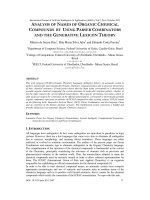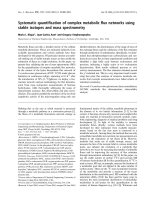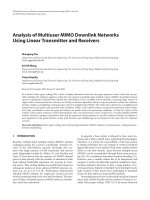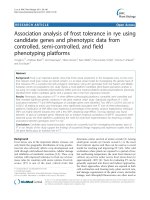MPI parallelization of fast algorithm codes developed using SIE VIE and p FFT method
Bạn đang xem bản rút gọn của tài liệu. Xem và tải ngay bản đầy đủ của tài liệu tại đây (877.69 KB, 76 trang )
MPI PARALLELIZATION OF FAST ALGORITHM
CODES DEVELOPED USING SIE/VIE AND P-FFT
METHOD
WANG YAOJUN
(B.Eng. Harbin Institute of Technology, China)
A THESIS SUBMITTED
FOR THE DEGREE OF MASTER OF ENGINEERING
DEPARTMENT OF ELECTRICAL AND COMPUTER
ENGINEERING
NATIONAL UNIVERSITY OF SINGAPORE
2003
ACKNOWLEDGEMENTS
This project is financially supported by the Institute of High Performance
Computing (IHPC) of Agency for Science, Technology and Research (A*STAR).
The author wishes to thank A*STAR-IHPC very much for its Scholarship.
The author would like to thank Professor Li Le-Wei in Department of Electrical &
Computer Engineering (ECE) and Dr. Li Er-Ping, Programme Manager,
Electronics & Electromagnetics Programme of Institute of High Performance
Computing for their instructions on my research.
The author also expresses his thanks to Dr. Nie Xiao-Chun in Temasek
Laboratories at NUS for the discussion with him during my research.
The author again thanks Mr. Sing Cheng Hiong in Microwave Research Lab. for
providing me many facilities in the lab he manages.
Finally, the author is grateful to his beloved wife and daughter in that they support
him in one way or the other to complete the present research while they keep
staying in China.
i
TABLE OF CONTENTS
ACKNOWLEDGEMENTS
i
TABLE OF CONTENTS
ii
SUMMARY
iv
LIST OF FIGURES
vi
LIST OF TABLES
vii
LIST OF SYMBOLS
viii
CHAPTER 1: INTRODUCTION…………..……………………………………..1
CHAPTER 2: BACKGROUND OF PARALLEL ALGORITHM FOR THE
SOLUTION OF SURFACE INTEGRAL EQUATION…………...4
2.1 Basic Concept of Parallelization…………………………………….5
2.1.1 Amdahl’s Law……………………….…………………………5
2.1.2 Communication Time………………….……………………….6
2.1.3 The Effective Bandwidth………………………………………7
2.1.4 Two Strategies on Communication….…………………………7
2.1.5 Three Guidelines on Parallelization….………………………...7
2.2 Basic Formulation of Scattering in Free Space……………………...7
2.3 The Precorrected-FFT Algorithm…………………………………...9
2.3.1 Projecting onto a Grid………………………………………11
2.3.2 Computing Grid Potentials………………………………….…11
2.3.3 Interpolating Grid Potentials……………………………….….12
2.3.4 Precorrecting…………………………………………….……12
2.3.5 Computational Cost and Memory Requirement………….…..13
2.4 RCS (Radar Cross Section)………..………………………………...13
2.5 MPI (Message Passing Interface)….………………………………...14
2.6 FFT (Fast Fourier Transform)………………………………….……16
2.6.1 DFT (Discrete Fourier Transform)………………………...…..16
2.6.2 DIT (Decimation in Time) FFT
and DIF (Decimation in Frequency) FFT………..……….…16
2.6.2.1 Radix-2 Decimation-in-Time (DIT) FFT…………….17
2.6.2.2 Radix-2 Decimation-in-Frequency (DIF) FFT……….18
2.6.3 The Mixed-Radix FFTs……………………………………….19
2.6.4 Parallel 3-D FFT Algorithm………………………………….20
2.6.5 Communications on Distributed-memory Multiprocessors….21
2.7 The Platform………………………………………………………..21
CHAPTER 3: PARALLEL PRECORRECTED-FFT ALGORITHM ON
PERFECTLY CONDUCTING………………..……………….25
3.1 Goal of Parallelization……………………………………………..25
3.2 The Parallel Precorrected-FFT Algorithm…………………………27
3.2.1 The First Way of Parallelization……………………………...27
ii
3.2.2 The Second Way of Parallelization…………………………...29
3.3 The Memory Allocation…………………………………………...33
3.3.1 The Memory Requirement of the Grid Projection
O (32Np3)……………………………………………………34
3.3.2 The Memory Requirement of the FFT O (128Ng)…………..36
3.3.3 The Memory Requirement of the Interpolation O (16Np3)…36
3.3.4 The Memory Requirement of the Correction Process O (8Nnear)
……………………………………………………………....37
3.4 The Computational Cost………………….…………………………38
3.4.1 The Cost of Computing the Direct Interactions……………..38
3.4.2 Cost of Performing the FFT………………………………...38
CHAPTER 4: MONOSTATIC AND BISTATIC SIMULATION RESULTS OF
PERFECT ELECTRIC CONDUCTOR……….………....41
4.1 Parallelization of the First Way…………………………………..41
4.2 Parallelization of the Second Way (Only Parallelizing FFT)…..42
4 . 3 P a r a l l e l i z a t i o n o f t he Se c o n d Wa y ( On l y Pa r a l l e l i z i ng
Correction)………………………………………………………..44
4.4 Parallelization of the Second Way (Parallelizing Correction and FFT)
………………………………………………………………..44
4.5 Bistatic RCS of a Metal Sphere…………………………………….45
4.6 Analysis of the Simulation Results……………………………….46
4.7 Experiments on Communication Time……………………………46
CHAPTER 5: PARALLEL ALGORITHM ON HOMOGENEOUS DIELETRIC
OBJECTS…………………………………………………………48
CHAPTER 6: PARALLELIZATION OF PRECORRECTED-FFT SOLUTION
OF THE VOLUME INTEGRAL EQUATIONS FOR
INHOMOGENEOUS DIELECTRIC BODIES…………………51
6.1 Introduction………………………………………………………….51
6.2 Formulation………………………………………………………….53
6.2.1 The Formulation and Discretization of the Volume Integral
Equation….…………………………………...………………53
6.2.2 The Precorrected-FFT Solution of the VIE……………..55
6.3 Parallel Algorithm……...……………………………………………57
6.4 Numerical Simulation Results……….……………………………..58
6.4.1 The RCS of an Inhomogeneous Dielectric Sphere with 9,947
Unknowns…………………………………………..…...58
6.4.2 The RCS of a Periodic and Uniform Dielectric Slab with
206,200 Unknowns……………………………..…….59
CHAPTER 7: CONCLUSION ON PARALLEL PRECORRECTED-FFT
ALGORITHM ON SCATTERING……………………………....62
REFERENCES…………………………………………………………………64
iii
SUMMARY
In this thesis, the author explores the parallelization of the Precorrected-fast
Fourier transform (P-FFT) algorithm used to compute electromagnetic field. The
Precorrected-FFT algorithm is a useful tool to characterize the electromagnetic
scattering from objects. In order to improve the speed of this efficient algorithm,
the author makes some efforts to implement this algorithm on high performance
computers which can be a supercomputer of multiple processors or a cluster of
computers. The author utilizes the IBM supercomputer (Model p690) to achieve
the objective.
The Precorrected-FFT algorithm includes four main steps. After analyzing the
four steps, it can be found that the computation in each step can be made parallel.
So the parallel proposed Precorrected-FFT algorithm has four steps. The main
idea of parallelization is to distribute the whole computation to processors
available and gather final results from all the processors. Because the parallel
algorithm is based on Message Passing Interface (MPI), the cost of
communication among processors is an important factor to affect the efficiency of
parallel codes. Considering that the speed of message passing among processors is
much slower than that of processor’s computing and accessing to local memory,
the parallel code makes the amount of data to be transferred among processors as
little as possible.
The author applies the parallel algorithm to the solution of surface integral
equation and volume integral equation with the Precorrected-FFT algorithm,
respectively. The computation of radar scattering cross sections of perfect
iv
electricity conductors and dielectric objects is implemented. The simulation
results support that the parallel algorithm is efficient. During the M.Eng. degree
project, a few papers are resulted from the project work. One journal paper and
two conference papers are published, and one journal paper was submitted for
publication in journal. The list of the publications is shown in the end of Chapter 1.
v
LIST OF FIGURES
Figure 2.1 Communication time…………….………………………………….6
Figure 2.2 Side view of the P-FFT grid for a discretized sphere (p=3)..……11
Figure 2.3 The four steps of the Precorrected-FFT algorithm……..…………11
Figure 2.4 The Cooley-Turkey butterfly………………….……………………18
Figure 2.5 The Gentleman-Sande butterfly……….…………………………...19
Figure 2.6 The loading flow of parallel codes………………..………………23
Figure 3.1 Relationship between grids spacing and execution time………….30
Figure 3.2 Steps 1-4…………………………………………………………....32
Figure 3.3 Basic structures of distributed-memory computers…….……….…34
Figure 3.4(a) The communication between the main processor and the slave
processors: Step 1……………………...……………..………..…35
Figure 3.4(b) The communication between the main processor and the slave
processors: Step 2……………..…………….………..………..…35
Figure 3.4(c) The communication between the main processor and the slave
processors: Step 3…...........…………………………..………..…36
Figure 3.4(d) The communication between the main processor and the slave
processors: Step 4………..……………………….…..………..…36
Figure 4.1 Parallel computing time I………...………………………………….42
Figure 4.2 Parallel computing time II…..…….…………………………………42
Figure 4.3 Parallel computing time III……....……………………………….….43
Figure 4.4 Parallel computing time V…………………………………………...44
Figure 4.5 Parallel computing time VI…………………………………………..45
Figure 4.6 Bistatic RCS of a metal sphere………….……………..…………….45
Figure 4.7 The communication time…………..………..…………………….…47
Figure 6.1(a) Top view of a sphere……………………..…………………….…53
Figure 6.1(b) Outer surface of one-eighth of sphere……..……………………...53
Figure 6.1(c) Interior subdivision of one-eighth of sphere into 27 tetrahedrons
…………………………………………………………………….53
Figure 6.2 RCS on an inhomogeneous dielectric sphere………..……………...59
Figure 6.3 Execution time with different processors…………….…………..…59
Figure 6.4 Bi-RCS of a periodic and uniform dielectric slab at k0h=9.0……....60
vi
LIST OF TABLES
Table 4.1 The communication time of different data transferred………..………47
Table 6.1 Execution time with different number of processors……….…………60
vii
LIST OF SYMBOLS
Symbol
Description
Ei
Es
nˆ
A
incident plane wave
scattered plane wave
unit normal vector
magnetic vector potential
electric scalar potential
Rao-Wilton-Glisson (RWG) basis functions
current
the unknown coefficients
Green’s function
impedance matrix
the vector
the inverse FFT
the electric field strength of the incident plane wave at a target
the electric field strength of the receiving antenna’s preferred
polarization
Φ
f n(r)
J
In
G (r , r ′)
Z
V
F-1
Ein
Er
viii
CHAPTER 1
INTRODUCTION
In this thesis, the author mainly delves how to apply the parallel precorrected-fast
Fourier transform (P-FFT) algorithm to the computation of scattered
electromagnetic fields. The results show that the parallel Precorrected-FFT
algorithm is an efficient algorithm to solve the electromagnetic scattering
problems.
The thesis includes 7 chapters. The following lists the major content of each
chapter (from Chapter 2 to Chapter 7).
In Chapter 2, some basic concepts relating to the Parallel Precorrected-FFT
algorithm on scattering are introduced concisely. These concepts are Message
Passing Interface (MPI), Radar Cross Sections (RCS), the Precorrected-FFT
algorithm, Fast Fourier Transform (FFT), the physical and virtual structures of
high performance computers, the parallel theory and communication cost.
In Chapter 3, details of the Parallel Precorrected-FFT algorithm are given. Two
ways of applying the algorithm are analyzed. The pseudo code of the algorithm is
written.
In Chapter 4, the experimental results of scattering by perfect electrics conductors
are presented and analyzed.
1
In Chapter 5, the parallel Precorrected-FFT algorithm applied to homogeneous
dielectric objects is introduced.
In Chapter 6, the Precorrected-FFT algorithm of volume integral equation for
inhomogeneous dielectric bodies is explained first. Then the parallel algorithm is
given and the results are detailed.
In Chapter 7, a conclusion of the parallel Precorrected-FFT algorithm on
scattering is reached.
Based on the above research, one journal paper and two conference papers have
been published and one paper has been submitted. These papers include:
(a) Book Chapter
1. Le-Wei Li, Yao-Jun Wang, and Er-Ping Li, “MPI-based parallelized
precorrected FFT algorithm for analyzing scattering by arbitrarily shaped threedimensional objects”, Progress in Electromagnetics Research, PIER 42,
pp. 247-259, 2003.
(b) Journal Papers
1. Le-Wei Li, Yao-Jun Wang, and Er-Ping Li, “MPI-based parallelized
precorrected FFT algorithm for analyzing scattering by arbitrarily shaped threedimensional objects” (Abstract), Journal of Electromagnetic Waves and
Application, vol. 17, no. 10, pp. 1489-1491, 2003.
2. Yao-Jun Wang, Xiao-Chun Nie, Le-Wei Li and Er-Ping Li, “Parallel Solution
of Scattering on inhomogeneous dielectric body by Volume Integral Method
2
with the Precorrected-FFT Algorithm”, Microwave and
Optical Technology Letters, vol. 42, no. 1, July 5, 2004.
(c) Conference Papers
1. Yao-Jun Wang, Le-Wei Li, and Er-Ping Li, “Parallelization of precorrected
FFT in scattering field computation”, in Proc. of International Conference on
Scientific and Engineering Computation (IC-SEC, 2002), Raffles City
convention Centre, Singapore, Dec 3-5, 2002. pp. 381-384.
2. Wei-Bin Ewe, Yao-Jun Wang, Le-Wei Li, and Er-Ping Li, “Solution of
scattering by homogeneous dielectric bodies using parallel P-FFT algorithm”,
in Proc. of International Conference on Scientific and Engineering
Computation (IC-SEC, 2002), Raffles City Convention Centre, Singapore,
Dec 3-5, 2002. pp. 348-352.
3
CHAPTER 2
BACKGROUND OF PARALLEL ALGORITHM FOR THE
SOLUTION OF SURFACE INTEGRAL EQUATION
The Precorrected-FFT algorithm is an efficient fast algorithm that can be applied
to the extraction of capacitance and calculation of scattered fields. The author will
only discuss how to parallelize the Precorrected-FFT algorithm for calculating
scattered field. The reason that parallelization is implemented on the PrecorrectedFFT algorithm is that PCs now can not satisfy many application requirements in
terms of memory and execution time. High performance computers provide a
good platform on which large problem can be solved. In order to efficiently utilize
high performance computers, it is necessary to explore how to parallelize the fast
algorithm. Although there are some compilers on high performance computers
that can automatically compile serial codes into parallel codes and run them, the
efficiency of the application codes complied by these compilers for a specific
algorithm may not be readily high. The best way of improving the efficiency is
that programmer manually parallelizes the required algorithm case by case. In this
thesis, we adopt Message Passing Interface (MPI) library on IBM p690 as the
platform that supports our parallel codes because MPI is a standard message
passing protocol supported by many vendors.
Before starting our discussion on parallelization of the Precorrected-FFT
algorithm for computing scattered electromagnetic fields, knowledge on parallel
concepts, MPI, the Precorrected-FFT algorithm, the concept of scattering on
objects by EM computations, Fast Fourier Transforms (FFTs), and the structure of
4
high performance computers (here referring to IBM model p690) is necessary.
Parallelization is a complex procedure which is related to many factors affecting
the efficiency of the algorithm of parallelization. Our task is to balance these
factors and find the best way to implement the task in accordance with the specific
requirements. We will introduce these factors one by one. Due to the limitation of
space, we will describe the concepts as short as possible.
2.1 Basic Concept of Parallelization
Simply to say, parallelization means that a task is carried out on multiple
processors of a high performance computer or a cluster of computers
simultaneously. But the procedure is not like the scenario that many PCs are
simply combined to work on a task. Generally, parallel codes running on a high
performance computer which uses complex protocols and algorithms to manage
the communication among processors and makes the processors cooperate with
each other harmonically. The communication capability is one of the critical
factors in parallelization. Furthermore, the case of a workload imbalance should
be deliberately handled with.
2.1.1 Amdahl’s Law
The general purpose of parallelization is to make codes run faster. However, there
is a limitation of improvement of running speed. The Amdahl’s law provides the
algorithm to estimate the limitation. Assume that in terms of running time, a
fraction p of a program can be parallelized and that the remaining 1-p cannot be
parallelized. Given n processors to run the program parallelized, according to the
Amdahl’s law, the ideal running time will be
5
1-p+p/n
of the serial running time.
So the most important task is to find out the fraction that can be parallelized, then
to maximize it.
2.1.2 Communication Time
The situation shown above is the ideal case. Actually, we need to consider the cost
of communication which generally occupies a great fraction of total cost. The
communication time can be expressed as follows:
Communication time =latency
+
Message size/bandwidth.
The latency is the sum of sender overhead, receiver overhead and the time of
flight, which is the time for the first bit of the message to arrive at the receiver. In
the following, Figure 2.1 shows the relationship of message size, latency and
communication time.
Communication time
latency
Message size
Figure 2.1 Communication time
6
2.1.3 The Effective Bandwidth
The effective bandwidth is calculated as follows:
Effective bandwidth= message size/communication time
= bandwidth/(1 + latency × bandwidth/message size).
The above equation shows that the larger the message is, the more efficient the
communication becomes.
2.1.4 Two Strategies on Communication
There are two strategies that can be applied to decrease the communication time:
1. Decrease the amount of data communicated; and
2. Decrease the number of times that data are transmitted.
2.1.5 Three Guidelines on Parallelization
In summarizing the above factors that affect the efficiency of parallelization, there
are three basic guidelines on parallelizing codes:
1. To maximize the fraction of your code that can be parallelized;
2. To balance the workload of parallel processes as equity as possible; and
3. To decrease the amount of data that are communicated among processors as
little as possible.
2.2 Basic Formulation of Scattering in Free Space
It is known that the electric field integral equation (EFIE) can be applied to both
open and closed bodies while the magnetic field integral equation (MFIE) limited
to closed surfaces. So we consider the EFIE when an arbitrarily shaped 3-D
7
conducting object illuminated by an incident plane wave Ei. According to
boundary condition of perfect electric conductor, the following equation can be
obtained:
nˆ × (Ei+Es) = 0
(2.1)
where Ei is an incident plane wave, Es is a scattering plane wave and nˆ is the unit
normal vector of the surface S of the conducting object.
Because
Es= − j ω A − ∇φ ,
(2.2)
substituting (2.2) into (2.1), we can get EFIE as follows:
nˆ × [ j ω A( r ) + ∇Φ ( r )] = nˆ × Ei(r) ,
(2.3)
where the magnetic vector potential A and electric scalar potential Φ are defined
as follows, respectively:
− jk r − r ′
µ
e
dS ′
A (r ) =
J ( r ′)
∫
s
4π
r − r′
1
Φ (r ) = −
4 π j ωε
(2.4)
− jk r − r ′
e
∫ ∇ • J (r ′ ) r − r ′
s
s
dS ′ .
(2.5)
To solve the EFIE with the numerical method, the conducting surface should be
discretized into small triangular patches. At the same time, we can expand the
current J in the way of using the Rao-Wilton-Glisson (RWG) basis functions
fn (r). Then we get
N
J(r) =∑ In fn(r) ,
(2.6)
n =1
where N is the number of unknowns and In denotes the unknown coefficients. In
free space, the Green’s function for a conducting object is
G ( r , r ′) = e
− jk r − r ′
r − r′
.
(2.7)
8
Applying the above method of moments leads to a linear system ZI=V.
Furthermore, we can get the expression of the impedance matrix Z and the vector
V as follows:
Zij =
jωµ
1
ti (r ) ⋅ fi (r ′)G(r, r ′)dr ′dr +
∇ ⋅ ti (r)∇′ ⋅ fi (r ′)Gr, r ′)dr ′dr
∫
∫
4π T i T j
4πjωε ∫T i ∫T j
(2.8)
Vi = ∫ ti (r) ⋅Ei(r)dr .
Ti
(2.9)
In (2.8) and (2.9), ti represents the testing function, fj represents the basis function,
and Ti and Tj are their supports, respectively.
On one hand, O (N2) storage space is needed because the impedance matrix Z is
fully populated. On the other hand, equation ZI=V demands O (N3) operations in a
direct scheme. So the requirements of memory and computation time are too huge
for a large object to be solved. However, this obstacle can be removed if we apply
the Precorrected-FFT algorithm which requires less memory and provides faster
speed than traditional Method of Moments (MoM).
2.3 The Precorrected-FFT Algorithm
The Precorrected-FFT algorithm was originally proposed by Joel R. Phillips and
Jacob K. White in order to deal with electrostatic integral equation concerned to
capacitance extraction problems [1,2]. Later, Xiaochun Nie, Le-Wei Li, Ning
Yuan, Yeo Tat Soon and Jacob K. White applied this method to the field of
electromagnetic scattering [3,4].
There are many methods that are used to characterize the electromagnetic
scattering. The most commonly used algorithms include the fast multipole method
9
(FMM), the adaptive integral method (AIM), the conjugate gradient-fast Fourier
transform method (CG-FFT), the multilevel fast multipole algorithm (MLFMA)
and the Procorrected-FFT algorithm (PFFT). All algorithms differ in that they
adopt different methods to iteratively compute the local interactions and
approximate the far-zone field or potential.
The basic idea of the Precorrected-FFT algorithm is that uniform grid potentials
are used to represent the long distance potentials and the nearby interactions are
directly calculated. Two prerequisites must be satisfied in advance. The first one is
that the object is discretized into triangular elements. The second is that the whole
geometry is closed in a uniform right-parallelepiped grid. Next, the PrecorrectedFFT method can start to work. This procedure concerns four steps that are (1)
projecting onto a grid, (2) computing grid potentials, (3) interpolating grid
potentials, and (4) precorrecting, respectively. Figure 2.2 gives an example which
shows that the space where a discretized sphere locates is subdivided into a
8 × 8 × 8 grid. Figure 2.3 displays the procedure of application of the Precorrected-
FFT algorithm [1].
Figure 2.2 Side view of the P-FFT grid for a discretized sphere (p=3) [1]
10
(1)
(4)
(2)
(3)
Figure 2.3 The four steps of the Precorrected-FFT algorithm [1]
A brief description of the above procedure is given below.
2.3.1 Projecting onto a Grid
Initially, a projection operator should be defined. The basic idea is that using the
point current and charge distributions on the grids surrounding the triangular
patches represent the current and charges distributions of these patches. Refer to
the paper [1] for more details of projection procedure.
2.3.2 Computing Grid Potentials
Once the charge projection to grids is finished, the potentials due to the grid
charges can be computed with a 3-D convolution. We denote it as
Aˆ
x, y ,z
(i,j,k)= H Jˆ x , y , z
=
∑ h(i-i’,j-j’,k-k’)Jˆ (i’,j’,k’)
i′, j′,k ′
(2.10)
where (i, j, k) and (i’, j’, k’) are triplets specifying the grid points and h(i-i’, j-j’, kk’) is the inverse distance between grid points (i, j, k) and (i’, j’,k’). The h(i, j, k)
is given by
11
h(i,j,k)=
µ
4π
− jk
e
(i ∆ x
(i ∆ x ) + ( j ∆ y ) + (k ∆ z )
2
2
2
) + ( j ∆ y ) + (k ∆ z )
2
2
2
(2.11)
with ( ∆x, ∆y, ∆z ) being the edge lengths of the grid. Using the Fast Fourier
Transform (FFT) can accelerate the computation of Equation (2.10),
Aˆ
x,y,z
= F-1
~
( H
⋅
~
J
)
(2.12)
x, y ,z
~
~
where F-1 denotes the inverse FFT, and H and J are the FFT forms of h(i, j, k)
and Jˆ (i, j , k ) , respectively.
2.3.3 Interpolating Grid Potentials
By adopting the similar process as the projection, the computed grids potentials
are interpolated to the element in each cell which surrounds the triangular patches.
2.3.4 Precorrecting
In order to eliminate the error due to the grid approximation, the near-zone
interactions need to be computed directly and to erase the inaccuracy caused by
the use of grid. Pay attention to that this process is sparse operation which can be
parallelized.
2.3.5 Computational Cost and Memory Requirement
According to [1], the computational cost and memory requirement are,
respectively
Cost=O(N)+O(N)+O(NglogNg),
3
3
Memory=O(32Np )+O(128Ng)+O(16Np )+O(8Nnear).
(2.13)
12
In the above equations, N is the number of unknowns, Ng is the number of rid
points, Nnear is the number f nonzero entries in near-field interactions and p is the
grid-order.
2.4 RCS (Radar Cross Section)
In electromagnetic field and applications, radar cross section is an important
concept. When radar works, it emits energy in the form of electromagnetic wave.
The receiving stations can receive the scattered wave when an object is on the way
where the electromagnetic wave propagates. The most important radar
characteristic of a target is its RCS. According to the sites of transmitting stations
and receiving stations, the characteristics of RCS can be seen from two important
types: monostatic and bistatic RCS.
For a monostatic radar the transmitting and receiving stations are placed at one
site. RCS is a quantitative characteristic of the target ability to scattered energy in
the direction opposite to the incident wave direction. When transmitting and
receiving stations are spatially separated, it may be required to take into account
the effects of different directions between the incidence angle and the scattering
angle. In this case, the required characteristic is referred to as the bistatic RCS of a
target.
From the general definition, the RCS of a target is equal to the surface area of a
symbolic object which scatters total incident energy isotropically and creates at a
distant receiving point the same power flux density as the target. In terms of the
electric field strength (which linearly relates to the instantaneous value or
13
amplitude of a signal), the RCS of a target (both monostatic and bistatic) can be
expressed as:
σ = lim 4π R2(|Er|2/|Ein|2) ≅ 4π R2(|Er|2/|Ein|2)
R →∞
where Ein is the electric field strength of the incident plane waves at a target, Er is
the electric field strength of the receiving antenna’s preferred polarization at the
distant receiving point, and R is the target distance from the receiving station.
2.5 MPI (Message Passing Interface)
MPI is a library specification for message passing interface, proposed as a
standard by a broadly based committee of vendors, implementers, and users in the
world. Because it is a popular interface standard, the MPI-based codes can be
transplanted to other computers easily. That is, the compatibility is excellent. This
is the reason that we choose MPI as the platform.
Message Passing Interface (MPI) is the definition of interface among a cluster of
computers or the processors of multiprocessor parallel computer. It provides a
platform on which users can reasonably distribute a task to a cluster of computers
or the processors of multiprocessor parallel computer. Someone also calls this
kind of structure ‘grid’. The concept of computing grid is borrowed from
electricity grid that supplies us electricity power.
The key problem that MPI-based programming relates is how to distribute the
tasks to processors according to the capability of each processor. There are two
main types of MPI-based supercomputers: shared memory and distributed
memory (i.e., local memory) machines. With the development of computer
14
technology, the speed of computing is much faster than that of accessing data. So
the way that data are accessed is one of the important elements that decide the
capability of MPI-based supercomputers or a cluster of workstations. What we
pursue is to reduce the access to data as little as possible.
It is easy to write programs on the MPI-based platform. Only a few functions in
MPI library are indispensable. With these functions a vast number of useful and
efficient codes can be written. Here shown is the list of these functions [16, 17,
18]:
(1) MPI_Init(ierr)
//Initialize MPI
(2) MPI_Comm_size(MPI_COMM_WORLD, numprocs, ierr)
//Find out how many processes there are
(3) MPI_Comm_rank(MPI_COMM_WORLD,myid, ierr)
//Find out which process I am
(4) MPI_Send(address, count, datatype, destination, tag,
comm)
//Send a message
(5) MPI_Recv(address,maxcount, datatype, source, tag,
comm., status)
(6) MPI_Scatter( )
//Receive a message
//scatter data from the processor
ranking 0 to the processors
ranking 1-n
(7) MPI_GATHER( )
//gather data from the processors
ranking 1-n to the processor 0
(8) MPI_BCAST( )
//broadcast data from the processor
ranking m to all processors
(9) MPI_Finalize(ierr)
//Terminate MPI
15
Since there will be frequent communications among processors when parallel
code runs, communication synchronization should be considered. MPI provides
four types of communication models which are (1) blocking send, blocking
receive; (2) blocking send, unblocking receive; (3) unblocking send, blocking
receive and (4) unblocking send, unblocking receive. In order to synchronize
communication between processors, the first model should be chosen. Details on
applying this model to the parallel Precorrected-FFT algorithm will be shown in
Chapter 3.
2.6 FFT(Fast Fourier Transform) [9]
2.6.1 DFT (Discrete Fourier Transform)
Fast Fourier Transform (FFT) is a fast algorithm solving the Discrete Fourier
Transform (DFT). It normally includes two kinds of sequential and parallel
algorithms. Sequential algorithms are mainly applied in computers with one
processor, while parallel algorithms in computers with multiprocessor
supercomputers or a cluster of workstations. The following formula is used for the
DFT:
1 2n
Xr=
∑ xlω-rl,
2n + 1 l =0
r= 0,1,…,2n;
(2.14)
where 1. The matrix equation is MX=x;
2. X={Xr, r=0, 1,…,2n} and x={xl, l=0, 1,…, 2n};
3. ω =
4. θ
l
=
e
θ =
j
1
2 lπ
,
2n + 1
e
2 jπ
2 n +1
; and
l=0,1,…,2n.
2.6.2 DIT (Decimation in Time) FFT and DIF (Decimation in Frequency)
FFT
16









